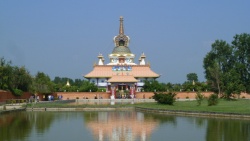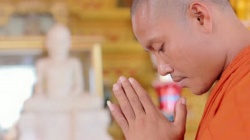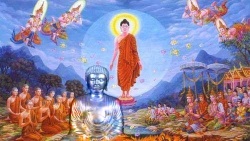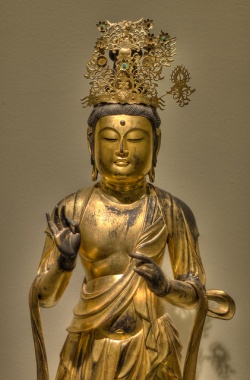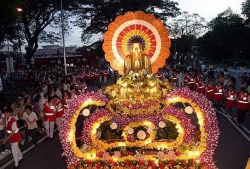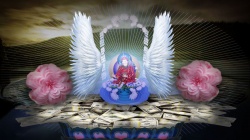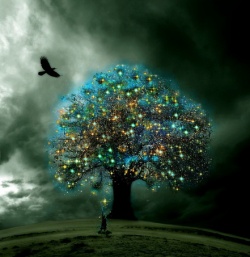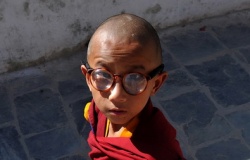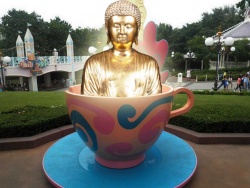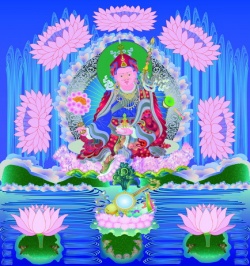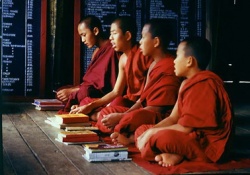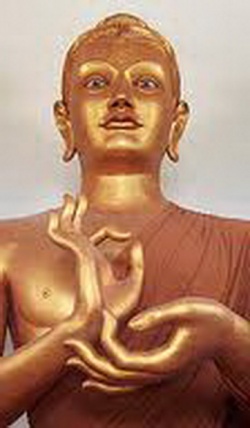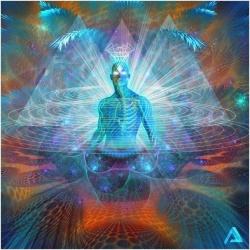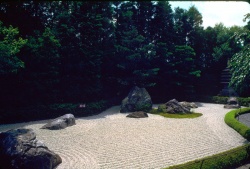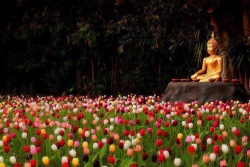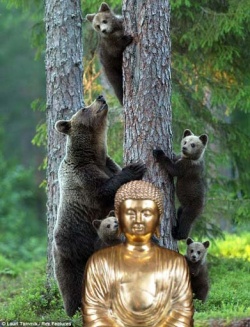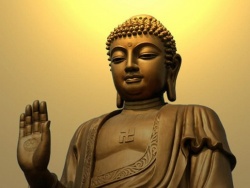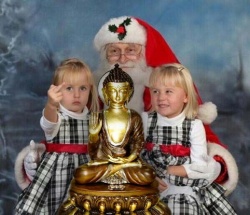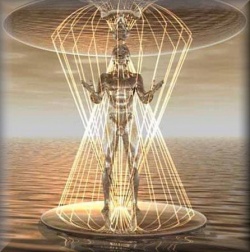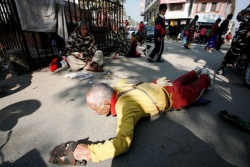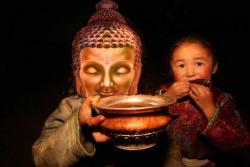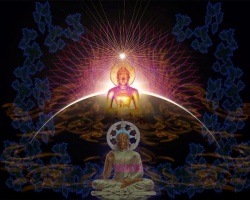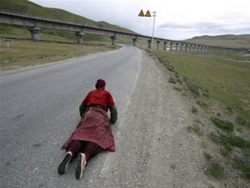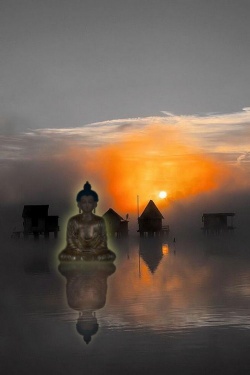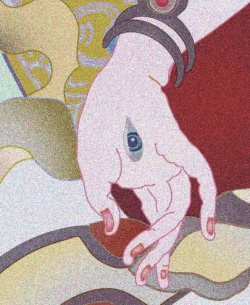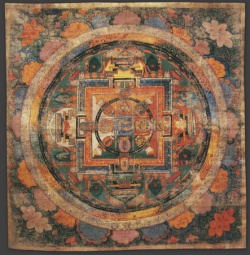Just another fundamentalist
While the spiritual insights of Tibetan Buddhism are truly majestic, its evolution has been bolstered or hindered by politics and personalities.
Fortunately for all of us, deeply charismatic and gifted Tibetan Lamas define the wondrous exploratory essence of Tibetan Buddhism, e.g., Padmasambhava, Naropa, Milarepa, Atisha, Tsongkhapa and the 5th, 13th and 14th Dalai Lamas.
Tsongkhapa and the current Dalai Lama (the 14th) are particularly exemplary because of their devotion to broad-based training, their respect for the various schools within Tibetan Buddhism and their prolific authorship of admired and sometimes provocatively illuminary treatises.
As noted by an NKT member in June (submitter of the essay on this web site entitled NKT Responds to NKTWorld):
The Dalai Lama is a dedicated ecclectic - someone who draws on elements of different religious tradtions and tries to form some coherent whole out of them.
He objects to the practice of Dorje Shugden because it is associated with a particular strand of Buddhism and because it offers the advice that we should avoid ecclecticism if we wish to make spiritual progress.
On this basis he also describes the practice of Dorje Shugden as "intensely sectarian." (The strand of 'Buddhism' mentioned here is Shugdenism, which has a militant history against 'non-believers')
Like all other human activities, Tibetan Buddhism has been hindered by bouts of narrow mindedness, sectarianism and deity deployments engineered to harm living beings.
The leading example of a 'wrong path' engineer is a contemporary figure - a Tibetan monk who severed his roots to create a fundamentalist exclusionary cult.
He promotes himself as Geshe Kelsang Gyatso, faith leader of a separatist organization he created in 1991, the New Kadampa Tradition (NKT).
Because he was never officially granted the Geshe degree, refused to take the qualifying exam for the degree (though Gyatso claims he took 2 preliminary exams) and was expelled by Sera Je Monastery because he is "Possessed by a terrible demon," he is hereafter referred to simply as Gyatso.
Gyatso (now 78) has steadily hardened his fundamentalist ideology over the past 30 years.
The seeds for his fundamentalism date back to his Buddhist training in Tibet in the dominant and sometimes dominating Gelug school. Gyatso's 'root guru' was Trijang Rinpoche (1901-1981), whose own root guru was Pabongkha (1878-1943). (see Footnote)
Some background history is in order.
Tsongkhapa (1357-1419) was ecumenical or inclusive in his training and in his teachings, i.e., he respected all traditions of Buddhism.
He revitalized the waning Kadampa school of Atisha (980-1054) - itself a revitalization of the nascent Tibetan Buddhism formulated by Padmasambhava and others in the 8th Century that later became known as the Nyingma school.
Tsongkhapa's students created the Gelug school.
Eventually, tensions between inclusionists (Tsongkhapa's legacy) and exclusionists developed in the Gelug school.
Exclusionists saw the Gelug school as the only pure path of Buddhism and turned toward militancy under Pabongkha,
who as regional head of government in eastern Tibet destroyed holy artifacts of Padmasambhava, who was seen in the Nyingma school as the 2nd Buddha. Nyingma monasteries were forcibly converted to Gelug property.
Phabongkhapa said that other traditions lead to hell and his protector would harm and kill Gelugpas that practiced from other traditions.
"Apart from the doctrine of Manjughosha Tsongkhapa alone, these days the views of all Sakyas, Kagyus, Nyingmas and so on are erroneous.
They are not even Svatantra or Cittamatra, let alone the view of Prasanga Madhyamaka– meditating only the nihilist view like tirthikas and Hashang.
If one upholds the nihilist view, the result is nothing other than going to Avichi hell. Since they can’t recognize subtle lethargy, even their meditation is defective.
Apart from the thunderous noise of their pretentious boasting about profound secret mantra, they don’t even know the direction of bliss and emptiness, luminosity, union and so on.
Since for them liberation and path of omniscience does not exist, realization will not arise even if they practice for a thousand years, as pointless as wishing for butter by churning water."
To assist their presumed birth right as the only pure path of Buddhism, the exclusionists (most importantly, Pabongkha) within the Gelug school promoted a minor deity known as Shugden from a worldly spirit to a full-fledged Buddha emanation of Buddha Manjushri.
When he was a human, Shugden was a rival of the 5th Dalai Lama in the 1600s and committed suicide in order to become a trouble-making spirit causing disasters against the Tibetan government and the Dalai Lamas' spiritual leadership to harmonize the various schools of Tibetan Buddhism.
Under Pabongkha, Shugden's duty was to protect the exclusionists within the Gelug school through violence and killing if necessary of non-Gelugpas (particularly the Nyingmas) as well as inclusionist Gelugpas. Shugden became a fierce iconic symbol of Gelug fundamentalists/exclusionists.
Pabongkha's exclusionists also demanded that Shugden replace the government's Dharma protector Pehar as well as the traditional Dharma protectors of the Gelugpas - Mahakala, Vaisravana and Kalarupa (who was the Dharma protector relied upon by Tsongkhapa).
Pabongkha's most important student, Trijang Rinpoche, maintained Shugden's dominance and the exclusionary approach, although reducing its militancy. About Shugden, Trijang Rinpoche wrote in his notes of Pabongkha's teachings:
"This protector of the doctrine is extremely important for holding Tshongkhapa's tradition without mixing and corrupting it with confusions due to the great violence and speed of his actions,
which fall like lightening to punish violently all those beings who have wronged the Yellow Hat tradition, whether they are high or low.
This protector is also particularly significant with respect to the fact that many from our own side, monks or lay people, high or low, are not content with Tsongkhapa's tradition, which is like pure gold,
and have mixed and corrupted this tradition with the mistaken views and practices from other schools which are tenet systems that are reputed to be incredibly profound and amazingly fast but are in reality mistakes among mistakes, faulty, dangerous and misleading paths.
In regard to this situation, this protector of the doctrine, this witness, manifests his own form of a variety of unbearable manifestations of terrifying and frightening wrathful and fierce appearances.
Due to that, a variety of events, some of them having happened or happening, some of which have been heard or seen, seem to have taken place: some people become unhinged and mad, some have a heart attack and suddenly die,
some see through a variety of inauspicious signs their wealth, accumulated possessions and descendants disappear without leaving a trace, like a pond whose feeding river has ceased, whereas some find it difficult to achieve anything in successive lifetimes."
(note: Shugden did not arrive on the scene until a couple hundred years after Tsongkhapa's death)
Debates over Shugden were largely constrained to internal debates within the Tibetan community until the 1970s, during which simultaneous interacting developments led to wider awareness of the Shugden controversy.
The Dalai Lama realized that his Shugden practice was misplaced, and his view began to disseminate.
The 1978 publication of The Yellow Book, which discussed the role of Shugden to shorten the lives of Gelugpas who practiced Nyingma teachings. The Dalai Lama, who is the historical leader of all Tibetan people, saw the book as worsening sectarian divisiveness and asked Tibetans to de-emphasize Shugden and to not consider Shugden a Buddha.
Tibetan Buddhism began spreading to the West through the efforts of Lama Yeshe and Lama Zopa of the Foundation for the Preservation of the Mahayana Tradition (FPMT).
FPMT invited Gyatso in 1977 to become a resident teacher at its main facility, the Manjushri Institute in England.
However, the forces of exclusionism did not have a unifying voice outside of Tibet, did not have a western PR machine and did not have a geopolitical base of operation. This was about to change.
Disillusioned with The Dalai Lama's political duty for and personal spiritual style of pluralism/inclusionism, Gyatso's ego realized the opportunities the West offered to create a fundamentalist version of Buddhism - a new 'pure' tradition unincumbered with the competition he would have in the Tibetan exile community in India and with The Dalai Lama.
Gyatso first set up a General Program of Buddhist study at the Manjushri Institute and for the first time in the West included courses about and ritual impowerments for the enigmatic subject of Tantra - a rich and to Westerners a provocative new world.
The number of students taking Gyatso's courses vastly outnumbered those taking courses in FPMT's teacher training program.
Strategically, and in recognition of the inclusionist environment at Manjushri Institute at the time, Gyatso's first books - to a degree - respected and referenced other viewpoints, including dedication in Meaningful to Behold to The Dalai Lama (later editions removed this dedication).
Gyatso opened an independent Buddhist center in York, England separate from the FPMT.
Causing friction, Gyatso was asked by Lama Yeshe and Lama Zopa to resign from Manjushri Institute.
However, because of the numbers of now fervent devotees to Gyatso and of the prohibitive maintenance expenses for the Institute's large historical building, Lamas Yeshe and Zopa lost control of Manjushri Institute.
The stress appears to have been intensified by a shocking blackmail against Lamas Yeshe and Zopa in 1983, when Gyatso threatened that he was prepared to turn over a 100-page report of illegal activities at Manjushri Institute, including drug smuggling, (for Gyatso's taped ultimatum, click here).
When Manjushri Institute's founder and spiritual leader died in 1984, Manjushri Institute was lost to Gyatso's regime. (for NKT's corporate statement about its takeover, click here - note NKT's threatened police action and legal action regarding alleged (not fact as wrongly published by NKT) serious criminal activities and drug smuggling by FPMT, effectively confirming the analysis above) (see footnote #2 below for NKT's Manjushri Institute revival)
Gyatso's first change at Manjushri Institute was to reverse the decline in Shugden practices that had occurred in deference to The Dalai Lama's advice to de-emphasize it.
In 1986, Gyatso taught the Shugden practice for the first time in English rather than Tibetan and required that the students commit exclusively to Gelug traditions of Tibetan Buddhism.
In 1987, Gyatso began a 3-year retreat in Scotland that can in retrospect be seen as the beginning of the end.
In 1988 and 1990, Gyatso's uncle (Kuten Lama) - the most famous Shugden oracle in the Tibetan community - visited England to enhance Shugden legend and devotion.
Gyatso's 3-year retreat intensified his metamorphosis toward fundamentalism. His 'realizations' included,
Tibetan Buddhism because of its pluralism and The Dalai Lama had degenerated in the direction of irrelevance and wrong path.
Only Gyatso could preserve (his distorted perception of) Tsongkhapa's teachings.
Inclusionism undermined the pure path of Gyatso's faith and intended movement.
Gyatso is the sole authority and savior of Buddhism.
Gyatso had to take advantage of Buddhism's 2,500 year history of kindness as a ploy to confuse new NKT recruits and the media while hiding NKT's fundamental ambition to subjugate all of Buddhism for his material pursuits and mind control of his followers.
Gyatso had to write about 2 dozen books, half of which would discuss Tantra with substantial promises of 'quick path' enlightenment to appeal to the western target audience.
Students had to be turned away from all forms of Buddhism but Gyatso's cult, including reading books of Tibetan Lamas or any other Buddhist teacher.
Non-Gelug books had to be removed from Manjushri Institute's expansive library, and ultimately the library itself had to be removed.
Gyatso and his students had to separate from Tibetan Buddhism, including the Gelug tradition, because they were degenerate.
With rare exceptions, Tibetan Lamas could no longer teach in one of his centers because they contributed to the degeneration of Tibetan Buddhism.
Respect for The Dalai Lama had to be discouraged, including removal of his pictures in Gyatso's centers.
Gyatso is the movement's root guru and only pure connection with Buddhism and Shakyamuni's lineage.
Gyatso had to deify Shugden and make Shugden worship a core practice in his new cult, which would be called the New Kadampa Tradition (NKT).
Further distort Shugden's original duty as a dharma protector to a Wisdom Buddha protector of NKT's followers' minds. Interestingly, Gyatso's Shugden ites purport a prevous incarnation of the Buddha Shugden was a student of Tsongkhapa, as was the first Dalai Lama.
This suggests that Shugden was a Buddha long before Tsongkhapa, who Gyatso claims is the second Buddha and attained his Buddhahood after his death (although simultaneoulsy considering Tsongkhapa an emanation of Buddha Manjushri rather than an independent Buddha). NKT's Buddha count is confusing.
Gyatso had to write a book dedicated to Shugden. (In this book, Heart Jewel, Gyatso presents a human form of Shugden named Biwawa, who lived in India long before the time of Tsongkhapa.
Biwawa could see Vajrayogini directly. When the King attempted many times to kill Biwawa, he invoked miracles to defend himself.
When asked to pay his bar bill, Biwawa claimed he had no money.
Becoming angry, the landlady gave him until sunset to pay. "Biwawa promptly used his miracle powers to stop the sun moving and held it motionless for three whole days." The King promised Biwawa he would not have to pay for his drinks or go to jail. How such a 'miracle' would not wreak havoc around the world and kill billions of living beings was not explained.)
Gyatso had to take advantage of the segment in western society who had become disenchanted with the pluralism/liberalism of the 1960s, and were, therefore, susceptible to pure-path faith marketing.
Gyatso had to market his fundamentalism as a panacea for selfishness, egotism and nirvana as techniques to cloud judgement, cultivate blind faith and produce willing soldiers for his fundamentalism.
Gyatso had to market NKT as the only pure dharma for the increasingly degenerate times.
Gyatso had to market Tsongkhapa as the second Buddha even though Tibetan Buddhists considered Tsongkhapa as an emanation of the Buddha Manjushri.
Gyatso had to market himself as the third Buddha, only the second to ever become a Buddha during human life, and the only living Buddha and seer of past, present and future.
Gyatso had to market the myth that he was all-knowing, all powerful, pure wisdom, pure compassion, pure kindness, omniscient, above all physical needs (i.e., does not need to eat, sleep, breath, use the toilet, etc), totally honest and had to load himself down with rocks or otherwise would involuntarily levitate when meditating.
However, when responding to critics, Gyatso had to pretend humility. For example, responding to a critic in 1996, Gyatso replied, "I will never pretend that I am a special person, like a holy being. I am just a foolish man."
Another Gyatso quote, "Friends, since you already have great knowledge and clear understanding, whereas I am of no importance, and have little wisdom, it is not suitable for you to request advice from me...I shall give you this advice from my inferior and childish mind."
NKT students will be instructed to look upon their NKT teachers as Buddhas.
Gyatso had to hold the Gelug school and western Buddhists (because of there proclivity to explore alternatives) as responsible for the degeneration of Tibetan Buddhism.
NKT will be the only guardian of a pure tradition of Tsongkhapa and Shugden worship.
NKT will be Shugden's greatest protector and benefactor. (According to the 100th Ganden Tripa, "If it (Shugden) were a real protector, it should protect the people.
There may not be any protector such as this, which needs to be protected by the people. Is it proper to disturb the peace and harmony by causing conflicts, unleashing terror and shooting demonous words in order to please the Dharma protector? Does this fulfill the wishes of our great masters.")
Gyatso had to remove his dedication for a long life to The Dalai Lama in his books.
Gyatso had to market to the world that he is the only living Buddha and descendent of Shakyamuni (the first individual to become a Buddha on earth).
Gyatso had to market himself as a messiah disguised as a humble monk.
Gyatso had to market the idea that any criticism of his fundamentalism exemplifies bias.
Only NKT will revitalize Tibetan Buddhism the way Tsongkhapa did in the 1400s.
NKT will create a western pure land.
Gyatso had to ignore that Tsongkhapa relied upon the teachings of all schools of Buddhism and relied upon Kalupa for his Dharma protector.
Gyatso's followers had to rely entirely on faith, and this faith must be directed only towards Gyatso.
Gyatso's text books are scriptures of a holy being.
NKT will not conduct charitible or political activities but concentrate entirely on spreading NKT dharma.
Political activities will be perpetrated though ad hoc organizations (e.g., the Dorje Shugden Charitable and Religious Society, Shugden Supporters Community, Western Shugden Society) to attack The Dalai Lama and the Tibetan people's devotion of him, Tibetan Buddhism and the Tibetan government.
Gyatso had to excommunicate or disrobe non-believers or sinners.
Gyatso had to focus Highest Yoga Tantra's meditation deity to Vajrayogini.
Gyatso had to replace all traditional Dharma protectors with Shugden.
Gyatso had to abandon his uncle (Shugden's primary oracle) because Shugden's elevation to a Buddha eliminated the oracle's relevance. (apparently, Gyatso considered his uncle a fake oracle because only worldly spirits and not Buddhas speak through oracles; his uncle left NKT and returned to the Tibetan community to support The Dalai Lama)
Gyatso had to market NKT as the only source of pure Buddhism in the world.
Gyatso had to promulgate the idea that he is infallible.
Gyatso had to dismiss the love and kindness of Tibetan Buddhists because they were degenerate.
Gyatso had to market the idea that financial donors will create merit towards less suffering in future lives as a ploy to enhance revenues.
Gyatso had to threaten legal proceedings against critics and those disputing Gyatso's version of Shugden's origins and history.
For example, in 1997, it was reported that Gyatso threatened legal action if criticism was published, and at NKT's 2008 summer festival, a similar report was circulated on the internet by an NKT member.
Gyatso wrote to a follower who felt compelled to leave him, "you are going against my spiritual wishes and as you say...rebelling against my system, such a thing has never happened before in Buddhist history."
(Gyatso's omniscience must have gone on vacation)
The poisonous 'fruits' of Gyatso's 'realizations' are presented throughout this web site. Gyatso's retreat was productive in NKT's mind.
Gyatso had perfected his vision and mission for purity and dominance. Gyatso had achieved his pure land of fundamentalism (a decade ago, Robert Thurman saw Gyatso's NKT regime the Taliban of Tibetan Buddhism).
When faced with criticism, NKT deflects it, arguing that "we have done nothing wrong" - the stereotypic response of corporations polluting the environment or marketing dangerous products.
It is saddening that Gyatso blames the plight of Tibetan Buddhism and the Tibetan people on Tibetan Buddhism because it has become degenerate, implying that the 6,000 Tibetan monasteries (only 13 now remain) destroyed by and the cultural genocide perpetrated by the communist Chinese government was caused by Tibetan Buddhism.
If the harmful impact of other religious and secular fundamentalists is relevant (e.g., Osama bin Laden, Hitler, Charles Manson, Jim Jones, David Karesh, etc), then we need to be concerned.
Gyatso's gullible devotees, selfishly taken in with false promises of nirvana and righteousness, readily see their egotistical monarch a messiah, just as the followers of other religious and secular fundamentalists looked upon their earthly patriarchic gods.
The imagery and anger of NKT voices now protesting against The Dalai Lama, in NKT's attack web sites, and in NKT's supporters' threats of bodily harm against NKT critics may someday produce serious casualties beyond the harm NKT is doing to Tibet and Tibetan Buddhism.
Based on Gyatso's actions and his progeny's attacks on Buddhism, Gyatso is neither a Buddha or a respectable Buddhist. His followers, most of whom are well-meaning and reaching out for something to believe in, are being duped by Gyatso's mesmerizing and radical fundamentalism.
Certainly, Tsongkhapa would not approve of Gyatso's distortions, boasts of pure path Buddhism, fundamentalism, worldwide PR campaign against The Dalai Lama, and assault on Tibetan Buddhism as degenerate and thus the cause for Gyatso's diagnosis of Tibet's demise.
(a few months before this photo, Gyatso directed Pema to implement his April 2008 email stating, "I personally will organise demonstrations against the Dalai Lama directly.
I requested Kelsang Pema and Kelsang Thubchen to do this job for me and they have accepted." note: NKT's public statements typically misrepresent Gyatso's direction of and NKT's leadership role in the protests against The Dalai Lama, assigning blame instead to NKT's ultra-ego, the Western Shugden Society, WSS)
FOOTNOTE
Responding to this and other web sites, NKT boasts purportedGyatso support from Trijang Rinpoche (1900-1981) and Yongdzin Ling Rinpoche (1903-1983, dying after Gyatso's apparent blackmail of FPMT).
Yongdzin Ling Rinpoche (whose devotional FPMT web page NKT links to in NKT's boast of his purported Gyatso support) was an FPMT teacher and senior tutor of The Dalai Lama,
who visited Yongdzin Ling Rinpoche on his death bed December 22, 1983 and consoled an audience that day grief sticken by The Dalai Lama's report about his poor health and announcement that in respect for Yongdzin Ling Rinpoche that day's event would be his last Vajrabhairava empowerment during the Lama's lifetime.
While both Trijang Rinpoche and Yongdzin Ling Rinpoche wrote dedications in three of Gyatso's early books, it is unlikely either would have supported Gyatso's departure from the Gelug school and Tibetan Buddhism (a decade after their deaths) or would have supported Gyatso's Shugden obsession and associated assault on Tibetan Buddhism, The Dalai Lama and the Tibetan people since the mid 1990s.
Notably, Gyatso rejected Yongdzin Ling Rinpoche's dedication to Highest Yoga Tantra Vajrabhairava practice for NKT (this Gelug and Kagyu liturgy was emphasized, promoted and written about by Tsongkhapa and Pobangkha; the 3 main meditational deities in the Gelug school are Vajrabhairava, Chakrasamvara and Guhyasamaja; Gyatso opted to focus on Vajrayogini). Once again, truth, integrity and compassion are foreign values to Gyatso and NKT.
In 2007, NKT produced a misleading DVD video about its creation of Manjushri Institute, noting falsely that "The history of Cornishead Priory and the history of modern Buddhism are inextricably woven together."
In 1160, a hospital was formed in Cornishead ran by the Black ommons, an monk order of St. Augustine. In 1537, Henry VIII seized and dismantled the hospital, evicting the monks as part of his dissolution of monasteries in England.
The property transferred to various owners which culminated in the Bradles, the last of whom commissioned Philip Wyeth in 1821 to build a new house. The project took 15 years and cost 140,000 pounds (10 million pounds in present value).
In 1848, Colonel Bradle declared bankruptcy.
In 1878, the house was converted to a hydropathic hotel, Paradise of Furness.
In 1929, the house was purchased for 35,000 pounds for use as a convalescent home for the patients from the Durham coal fields by the Durham Miners Welfare Committee.
In 1951, the house and its contents were auctioned. After remaining empty for 5 years, the gutters were blocked, allowing water to enter the building, causing widespread dry rot in almost every wall and timber. The magnificent structure was on the verge of collapse.
In 1976, western Buddhists purchased the estate determined to restore the building so that it once again would be home to a spiritual community.
This time, it was destined to become a hub of a global network of meditation centers. In 1977, Gyatso was invited to become the resident teacher. Trijang Rinpoche encouraged his desciple to proceed because he believed that Gyatso has important work to do to spread Kadampa Buddhism throughout the world.
The building, now called Cornishead Priori, was restored by the presence of Gyatso. "At the beginning and end of the working day, the community would gather at his feet to listen to his teachings."
The restoration was aided by government grants, voluntary donations and proceeds from Gyatso's books.
In 1991, what had been called since 1976 as Manjushri Institute was dissolved and its assets turned over to a new corporation, Manjushri Mahayana Buddhist Centre.
Notably MISSING from this misleading chronicle was ANY mention of Lama Yeshe and the Foundation for the Preservation of the Mahayana Tradition, which ACTUALLY purchased Cornishead Priori in 1976 for 70,000 pounds,
owning and operating it until hostile takeover by Gyatso in 1983, co-opting Lama Yeshe's vision for Manjushri Institute (in 1984, Lama Yeshe died at the age of 49, most likely at least in part due to the stress of the hostile takeover and Gyatso's exclusionist plans to dominate Buddhism in the West).
Also missing from NKT's DVD was NKT's removal of over 3,000 books, some of them very rare, from Manjushri Institute - replaced by Gyatso's books. In 1991, Gyatso unveiled the fruition of his global plan, NKT.
Editor's note:
For deeper analysis of NKT see the links and other texts on this web site's Read More page and the excellent text and references in David N. Kay's book, Tibetan and Zen Buddhism in Britain, which documents Gyatso's rise.
While NKT considers Dr. Kay's treatise biased, it has become obvious that NKT considers everything but the 'pure path' of its cult as biased.
This is the inherant problem with fundamentalist cults - they see themselves as the only ones having unbiased views in the universe.
On September 10, 2008, NKT, attempting to claim that it was not fundamentalist, published...
"The definition of fundamentalism in Wikipedia is “deep and totalistic commitment” to a belief in, and strict adherence to a set of basic principles (often religious in nature), a reaction to perceived doctrinal compromises with modern social and political life.
Fundamentalism is therefore clinging to a set of principles in reaction to the perception that too much compromise of these principles has been made in the modern world."
